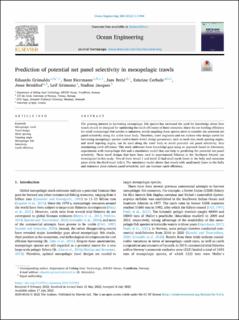| dc.contributor.author | Grimaldo, Eduardo | |
| dc.contributor.author | Herrmann, Bent | |
| dc.contributor.author | Brčić, Jure | |
| dc.contributor.author | Cerbule, Kristine | |
| dc.contributor.author | Brinkhof, Jesse | |
| dc.contributor.author | Grimsmo, Leif | |
| dc.contributor.author | Jacques, Nadine | |
| dc.date.accessioned | 2022-11-04T09:52:34Z | |
| dc.date.available | 2022-11-04T09:52:34Z | |
| dc.date.created | 2022-08-11T13:00:40Z | |
| dc.date.issued | 2022 | |
| dc.identifier.citation | Ocean Engineering. 2022, 260, 1-22. | en_US |
| dc.identifier.issn | 0029-8018 | |
| dc.identifier.uri | https://hdl.handle.net/11250/3030115 | |
| dc.description.abstract | The growing interest in harvesting mesopelagic fish species has increased the need for knowledge about how trawls should be designed for optimizing the catch efficiency of these resources. Since the net herding efficiency for small mesopelagic fish species is unknown, trawls targeting these species need to consider the potential net panel selectivity along the entire trawl body. Therefore, trawl engineers and net makers who design trawls for harvesting mesopelagic species need to know which design parameters, such as mesh size, mesh opening angles, and trawl tapering angles, can be used along the trawl body to avoid potential net panel selectivity, thus maximizing catch efficiency. This study addresses these knowledge gaps using an approach based on laboratory experiments with mesopelagic fish and a simulation model that can help in predicting the potential net panel selectivity. Three trawl designs that have been used in experimental fisheries in the Northeast Atlantic are investigated in this study. Two of them (trawl 1 and trawl 2) had small-mesh liners in the belly and extension piece while the third trawl didn't. The simulation model shows that trawls with small-mesh liners in the belly and extension piece reduces panel selectivity and can increase catch efficiency. | en_US |
| dc.language.iso | eng | en_US |
| dc.publisher | Elsevier | en_US |
| dc.rights | Navngivelse 4.0 Internasjonal | * |
| dc.rights.uri | http://creativecommons.org/licenses/by/4.0/deed.no | * |
| dc.subject | Catch efficiency | en_US |
| dc.subject | Selectivity | en_US |
| dc.subject | Mesopelagic fish | en_US |
| dc.subject | Tapering angle | en_US |
| dc.subject | Mesh opening | en_US |
| dc.subject | Trawl design | en_US |
| dc.subject | Mesopelagic trawl | en_US |
| dc.title | Prediction of potential net panel selectivity in mesopelagic trawls | en_US |
| dc.title.alternative | Prediction of potential net panel selectivity in mesopelagic trawls | en_US |
| dc.type | Peer reviewed | en_US |
| dc.type | Journal article | en_US |
| dc.description.version | publishedVersion | en_US |
| dc.rights.holder | © 2022 The Authors. Published by Elsevier Ltd | en_US |
| dc.source.pagenumber | 22 | en_US |
| dc.source.volume | 260 | en_US |
| dc.source.journal | Ocean Engineering | en_US |
| dc.identifier.doi | 10.1016/j.oceaneng.2022.111964 | |
| dc.identifier.cristin | 2042416 | |
| dc.relation.project | EC/H2020/817669 | en_US |
| dc.source.articlenumber | 111964 | en_US |
| cristin.ispublished | true | |
| cristin.fulltext | original | |
| cristin.qualitycode | 1 | |

